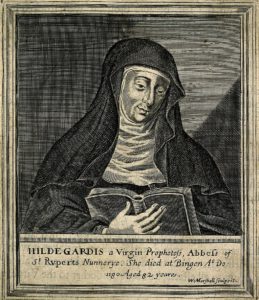The sounds of ancient music reverberated through the King’s Chapel and into the homes of many with the latest Night FYP lecture: a YouTube video titled, “Chanting the Mysteries: Gregorian chant from late antiquity to Hildegard” by Paul Halley and members of the King’s College Chapel Choir. On November 5, FYP students were treated to a selection of ancient Gregorian chants and songs, along with a historical overview of Gregorian chant from the early centuries of Christianity to the nineteenth century. FYP students have just finished Section 2, which encompassed the Middle Ages and, having explored the foundations of many religious traditions, it was only fitting to have a lecture which brought both sections 1 and 2 together by exploring music that spans both.

Engraving of German abbess and physician Hildegard von Bingen. Courtesy of the Wellcome Collection.
Halley first discussed the origins of plainchant (chant that is, well, plain) in Jewish worship tradition. Plainchant was adapted and changed over time by early Christians until it evolved into a robust musical tradition that spawned schools of music and transcontinental interactions in Europe and the Middle East. Students in attendance experienced the earliest form of plainchant from the choir, and heard how it might have developed from reading passages of the Bible. Plainchant is different from modern music in several respects. It uses only four bar lines (instead of the five we use today) and is written with square notes rather than the regular circular notes now used. Rather than following the typical scale of seven notes (CDEFGAB), plainchant instead has singers find pitches relative to the first pitch.
This was followed by a discussion of liturgical chants sung at the Christian daily offices (prayers said at certain times of day in observance of church laws), and the development of organum, a specific type of harmonic singing. Then, polyphony was introduced, which keeps the normal chant line but also adds other voice parts to incorporate different timing and harmonies. Viewers were also introduced to two major composers of the French school of Gregorian chant: Léonin and Pérotin. To conclude the lecture, the choir gave a rendition of Hildegard of Bingen’s O Virga ac Diadema. Hildegard is arguably the most famous female composer of early music, and was a mystic, scholar and nun, among other titles.
After the screening of the lecture, students and faculty were invited to a Zoom Q&A session with some of the chapel choir, and were given a chance to sing Te Lucis, a plainchant hymn sung during one of the daily Christian offices called Compline. Paul Halley and his assistant director Nick Halley fielded questions from participants about all things related to Gregorian chant. The conversation was so lively—including debates about whether musical key signatures existed, and how chant developed in later years—that only ten minutes remained to dive into the plainchant lesson.
The lecture brought the beauty of early music to the homes and screens of the King’s community—a fitting note to bring us into the Reading Week.
Banner image titled, “Plainchant” (source: Flickr/say_cheddar)

